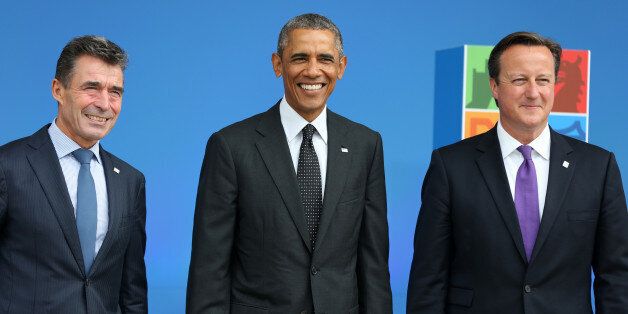
More than 60 leaders are attending a historical NATO summit in Wales this week. On the agenda are the political crisis in Afghanistan, the rise of the Islamic State group in Syria and Iraq and most prominently, the pressing concern of the unabated tensions in Ukraine.
Since the start of the conflict between the Ukrainian government and separatists in the east of the country, NATO Secretary-General Anders Fogh Rasmussen has developed into one of the staunchest critics of the Russian role in the crisis. Just on Thursday, Rasmussen accused Moscow in a series of tweets of consistently escalating the crisis and trying to grab Ukrainian territory by force.
But despite the saber-rattling rhetoric ahead of this summit, the grim reality is that there is not a lot NATO can actually do for the government in Ukraine.
A Little Background On NATO
NATO, or the North Atlantic Treaty Organization, was created in 1949 with 15 members, mostly comprised of north Atlantic and western European nations. The first head of NATO described its purpose at the time as "to keep the Russians out, the Americans in, and the Germans down.” Since its inception, NATO been the favorite instrument of collective security in the west, and for much of its history it has viewed Russia as the greatest threat to that security.
An excellent brief history of NATO's role in Europe by the Guardian.
Why NATO Can't Do All That Much For Ukraine
First and foremost this is because Ukraine isn't a member state of NATO, but a partner, and thus isn't subject to the most important part of NATO's treaty -- Article V. This is the part of the treaty that stipulates that an attack against one NATO member is considered an attack against all, and obligates member states to defend their attacked colleague. It has thus-far only been invoked once, by the United States on Sept. 12, 2001. America's invocation of the collective defense system against the terrorists who carried out the 9/11 attacks eventually transitioned into NATO's still-ongoing operation in Afghanistan.
Article V is considered to be NATO's most powerful deterrent against foreign intervention, and one of the main reasons some non-NATO countries would like to join the alliance. Conversely, it also makes NATO members understandably hesitant to let prospective nations in, lest they increase the risk of being drawn into their conflicts.
NATO is particularly wary of expanding to the east because of a 1997-pact with Russia, dubbed the NATO-Russia Founders Act. Aiming to reach a sort of detente in the wake of the Cold War, the agreement stipulates that both NATO and Russia agree to work together on security instead of allowing the build-up of forces in certain regions of Europe, including central and eastern Europe. As the current crisis shows, this didn't exactly pan out. Nevertheless, the commitment to the act is something that has led NATO states to be reluctant about any expansion plans over fear of violating the agreement and disintegrating relations with Russia any further.
Ukraine itself was denied membership back in 2008, largely because of French and German concerns over upsetting the balance of power in Europe.
Another issue is the cost of NATO membership expansion or possible military aid. The United States has repeatedly called on other member states to meet the target figure of dedicating 2 percent of their GDP over 10 years to military spending in order to beef up the security organization, a target currently only 4 in 28 members meet.
While it's easy to criticize member states for "not pulling their weight," it's actually very reasonable for some of these dissenting countries to abstain from the spending. As political scientist and NATO-expert Stephen Saideman notes on his blog, the 2 percent figure doesn't take into account all the other metrics of how states contribute to NATO, nor their political restrictions on spending more. Canada, he shows, would need to nearly double its defense budget to meet the goal. If NATO would take into account metrics such as Canadian casualties or the number of troops the country has contributed to NATO missions, Canada actually out-contributes countries who already meet the 2 percent goal.
What This NATO Summit Is Doing
So far the organization has promised to set up a 12 million Euro trust fund to boost Ukraine's military capabilities, which is far from the weapons or membership Kiev requested. Responding to growing fears of a Russian incursion in the Baltic States of Latvia, Estonia and Lithuania, the alliance also established a Readiness Action Plan that promises a mobile 4,000-strong force to respond to any incursions into European member states.
Cold comfort for Ukraine, since they're not one of them.
